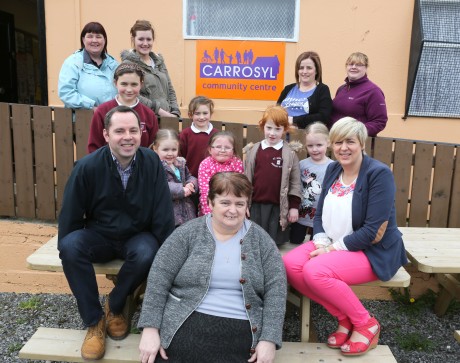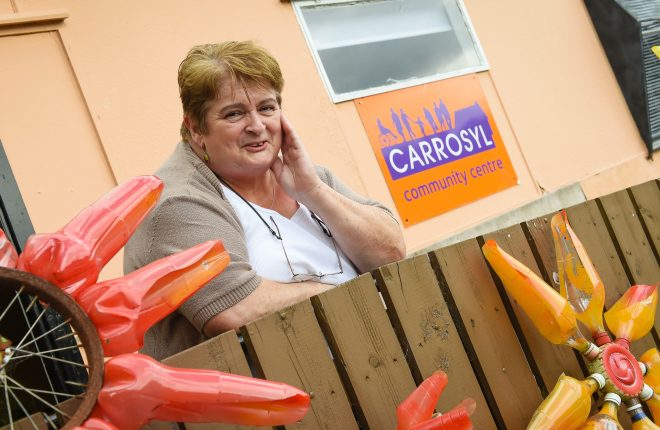
COMMUNITY… Front: Sean Keenan (Building Peace Through The Arts Project Manager – Arts Council NI), Kathleen Breen (Carrosyl Community Facilitator) and Stephanie Kenny-Quinn (Arts Facilitator) with volunteers and children from Carrosyl Community Centre, Lisnaskea
By Ryan Smith
DRIVING through Sylvan Hill and Carrowshee Park in Lisnaskea, or Carrosyl as they’re collectively known, the work that has been going on in the area in the last decade is evident.
It is clean; new ramps have slowed cars that were posing a threat to children; and hidden at the top of the estates, at the former ‘back field’ is a community centre and well-equipped play area in a part of the estate that had be infamous for trouble prior.
There are 260 houses, and around 550 residents with a predominantly Catholic make-up (79%); while in a recent housing executive survey, 86% of residents were described as very satisfied and satisfied living among the two estates.
The community association was set up in 2001 after widespread concern in the area following the closure of three factories, who were major employers.
And, recapping on over a decade of work, Kathleen Breen, who was one of the first residents in Carrowshee when it was started in 1980, is keen that the work continues.
Kathleen is also secretary of the association.
Sylvan Hill is the older of the two estates, and housed many factory workers from the Sir Richard Arkwright factory from the period of the 1960s until its closure.
Carrowshee Park has been built in phases since 1980, the most recent addition being in 2009 when, through Oaklee Housing, 22 new houses were built as part of ‘Carrowshee Avenue’.
“We started in 2001,” Kathleen explained, “at that time there was a lot of unemployment in the town because the three main employers, the factories, had closed down. Sir Richard Arkwright, the cheese factory and Adria had all closed down within a two year period.
“That left a lot of unemployment. At that particular time there was a downbeat atmosphere about as the majority people worked in the factories.
“As well as a difficult atmosphere, residents wanted something to be done about the main thoroughfare into the area, the general appearance of the estates and more facilities for young people.
“The road issue was just people driving too fast – kids out playing and you’d be standing at your doorstep thinking how can people survive.”
The ramps finally came in September of last year: “It makes a huge difference, it really does.”
Trees and flowers have been planted, and the general appearance of the area has been improved, and a lot of work has been done to both eradicate the notorious ‘back field’, and transform it into a hub for children and teenagers.
The back field was derelict, used for dumping and all sorts of unsavoury and anti-social behaviour,” explained Kathleen.
“As a parent, my boys played outside and got into all sorts of trouble but when you heard tell of them being in the back field it was a absolute nightmare. Because you knew there was nothing good going on there.”
Kathleen went on: “We had earmarked the back field as one of the safest areas for a playpark in terms of location. We worked with the council and got funding from Children in Need, the play area was done, and the People’s Millions for the multi-sports area.”
In terms of age demographic, Kathleen described the estates’ population as ‘fairly elderly’, although there is also a relatively large number of single parent families.
“At the moment it would seem like we have a lot of younger kids. When we started we would have had what we would call the older teenagers: 14 – 18. But they’ve moved on, and our predominant teenage group would be 12 – 14. We also have a big group of primary school kids attending our youth clubs,” she added.
A recent survey highlighted issues that the group seeks to address.
“Older people don’t have much to do. One thing people were keen on was a neighbourhood watch scheme – so we’re going to try get that off the ground.
“Young people find Lisnaskea a remote place to live in and the bus service is irregular. They can get into Enniskillen for the cinema or the like on the bus, but to get home is expensive with taxis. We’re a rural community but people see it as urban. It’s difficult to know how you address that.
“Car parking is also an issue, and people are having to park on the curbs.”
And, a number of sudden deaths in the area have also prompted a look at what can be done.
“We would love to see some way of helping to address that situation and prevent any further deaths. You just feel so helpless – you think what can we do to prevent anyone else going down the same road.
“It’s very scary, and all you can do at the time is support the families. But you step back and think, ‘What else can we do?’ and it’s about finding out what that is.”
Ten years on from its inception the Carrosyl Community Association has been true to its mission statement and is still very much at the heart of the community.”
As the association celebrates an art council grant that will allow a public piece of art in the area, Kathleen is proud of what has been achieved: “Our achievements have been massive when you look at them. If anyone has a problem at all, they know who is on the committee – or they’ll stop you in the street.
“We want to be accessible, we’re here for everybody.”
To read more.. Subscribe to current edition
Receive quality journalism wherever you are, on any device. Keep up to date from the comfort of your own home with a digital subscription.
Any time | Any place | Anywhere









